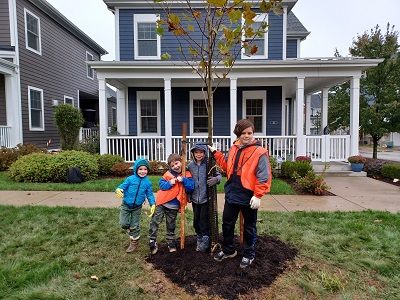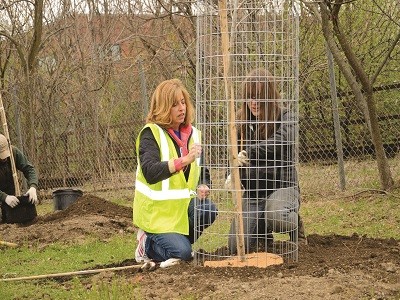Pittsburgh, Pa. – September 9, 2022 – Trees do so much more than provide shelter from the elements and homes for wildlife. Their beauty calms us and can even increase a home’s property value. They reduce noise, heat, glare and stormwater runoff. These workhorses of the environment filter pollutants and provide life-giving oxygen.
Inspired to plant a tree in your yard? Great! The Western Pennsylvania Conservancy and our partners recommend planting native species—those which occur naturally or existed for many years in an area. Hardy and resistant to disease and pests, native trees are crucial to restoring local ecosystems and increasing biodiversity.
“For a backyard planting, there’s virtually no reason to plant a non-native tree,” says Brian Crooks, Conservancy community forester and a certified International Society of Arboriculture arborist. “There are many trees native to Western Pennsylvania, including small flowering trees like redbud or serviceberry, shade trees like swamp white oak or blackgum and wetland trees like sycamore and shagbark hickory.”
To give your leafy friends every opportunity to thrive, Brian recommends considering the following when buying and planting trees.
Above Ground
- How big is your yard? How big will your tree be in 20 or 40 years?
- Are there overhead power lines?
Below Ground
- Are there underground gas, electric and sewer lines? “It’s best not to plant directly over those,” Brian says. Call 800-242-1776 or visit pa1call.org to learn locations.
- How much space is there for root spread?
- Is your soil compact or loose, clay or sand, wet or dry? Is there construction fill?
General Environment
- “Consider your area’s hardiness zone, which indicates the region’s average lowest temperature,” says Brian. Plants are labeled with their preferred zone. Western Pennsylvania’s hardiness zones range from 5A to 6B. Find the U.S.D.A. Hardiness Zone Map at planthardiness.ars.usda.gov.
- Will the tree get full shade, full sun, cooler morning sun or hotter evening sun?
- Do you want your tree to mitigate flooding, provide shade, fruit, flowers or fall foliage or do something else?
Municipal or Regional Considerations
- Does your municipality have tree ordinances for private properties?
- Does your region have disease or pest issues? “Ask your county conservation district, a university extension office or local shade tree commission,” Brian suggests.
Shopping for a Native Tree
- Take your checklist and talk with a knowledgeable tree professional about which native trees suit your yard. “A local nursery dedicated to growing and selling native trees is an excellent place to start,” Brian says.
- Shop by a tree’s Latin name. “Don’t get fooled by pretty marketing names,” Brian cautions. “A Norway maple at one nursery might be called a Crimson King maple at another, but every plant has one scientific name that will never lead you astray.”
- Know where the tree originated. “Don’t inadvertently spread disease by buying a tree that came from an area where a disease exists,” Brian says. “For example, several Eastern Pennsylvania counties are under quarantine due to the invasive spotted lanternfly.”
Planting
- “Being uprooted and transplanted is unlike anything trees are biologically designed to do,” says Brian. “Reduce their stress by planting in October, November, March or April, while they’re dormant. Never plant in the summer!”
- Remove all packaging materials. “Remove the cage around the root ball; otherwise the roots will grow in circles,” Brian says. “Even biodegradable burlap wicks moisture away from roots.”
- Visit WaterLandLife.org/PlantTrees for illustrated instructions and videos on tree planting.
- For tree care you can’t do, always hire an arborist certified by the International Society of Arboriculture. Visit isa-arbor.com.
- Volunteer at a Conservancy tree planting to learn more about tree planting. Visit WaterLandLife.org or call 412-586-2386 to find out about upcoming tree plantings.
###
About the Western Pennsylvania Conservancy:
The Western Pennsylvania Conservancy (WPC) enhances the region by protecting and restoring exceptional places. A private nonprofit conservation organization founded in 1932, WPC has helped establish 11 state parks, conserved more than a quarter million acres of natural lands, protected or restored more than 3,000 miles of rivers and streams, and assessed thousands of wildlife species and their habitats. The Conservancy owns and operates Frank Lloyd Wright’s Fallingwater, which is on the UNESCO World Heritage List and symbolizes people living in harmony with nature. In addition, WPC enriches our region’s cities and towns through 130 community gardens and other green spaces that are planted with the help of more than 7,000 volunteers. The work of the Conservancy is accomplished through the support of more than 10,000 members. For more information, visit WaterLandLife.org or Fallingwater.org.
